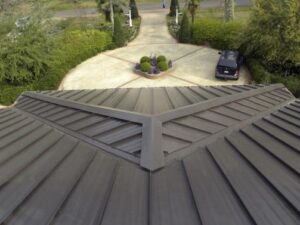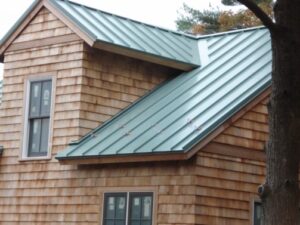 Standing seam metal roofs are by far the most popular style of metal roofing in both residential and commercial building applications. It has also been the longest installed type of metal roofs, dating back to when all metal roofing was typically hand-made from copper or tin. Today, standing seam metal roofs are commercially manufactured by numerous big metal roofing manufacturers, as well as thousands of smaller roofing outfits with their own sheet metal shops and rolling machines.
Standing seam metal roofs are by far the most popular style of metal roofing in both residential and commercial building applications. It has also been the longest installed type of metal roofs, dating back to when all metal roofing was typically hand-made from copper or tin. Today, standing seam metal roofs are commercially manufactured by numerous big metal roofing manufacturers, as well as thousands of smaller roofing outfits with their own sheet metal shops and rolling machines.
Most of the standing seam metal roofs installed today are 24 gauge panels with high quality paint coating, baked on in seven layers (including primer) in the controlled factory environment when the metal coil is manufactured. After the painting process the coil is slit into various sized and delivered to manufacturers of metal roofs, where it is roll-formed into pre-measured length panels, either on site or in the metal shop. Then the panels are delivered to the job site where they are measured, trimmed if necessary, and installed on the roof deck.
Most common profiles of standing seam roofs are 16″ panels – either snap-lock or mechanical lock profiles. Snap lock allows the metal roofing contractors to quickly install the roof by snapping one panel into receiving the lock of the previous panel. Snap lock panels can be installed from left-to-right or vice versa, or even from a center starter panel in either direction.
 Contrary to conventional wisdom, metal roofing is far more difficult to install than most people think. Installing metal roofing is not the same as shingling an asphalt shingle roof. Metal roofing panels have to be measured, and cut with great precision to ensure water tightness and integrity of the metal roofing system. The installation of the roof chimney, skylights, valley and wall flashing requires special knowledge, tools, experience and extensive training.
Contrary to conventional wisdom, metal roofing is far more difficult to install than most people think. Installing metal roofing is not the same as shingling an asphalt shingle roof. Metal roofing panels have to be measured, and cut with great precision to ensure water tightness and integrity of the metal roofing system. The installation of the roof chimney, skylights, valley and wall flashing requires special knowledge, tools, experience and extensive training.
In a typical metal roofing system, panels interlock together side by side, and sometimes metal roofing panels interlock on all four sides, as is the case with metal shingles. At this point in time we will focus on standing seam metal roofing.
The Metal Roofing Installation Process
When installing a standing seam metal roof it is recommended that the roof decking be smooth and free from any foreign materials to prevent the telegraphing effect through the panels. Sometimes metal roofing systems replace asphalt shingle roofs where horizontally installed shingles can punch through vertical mounted roof panels, creating ugly dents which cannot be fixed or removed unless the entire panel is replaced… Need I explain that preparing the surface is not as costly as replacing metal panels? Further, it is essential that the roof decking be protected with ice and water shield, preferably Grace Ice and Water shield because it is smooth and allows the panels to expand and contract easily.
Another important thing to keep in mind is the metal roof itself. When ordering metal roofing materials, it is important to correctly measure the length of your panels, so that you don’t end up with panels that are too short and are unusable.
A standing seam metal roof is usually attached to the roof deck with fasteners(typically 1 inch wide head screws with a washer.) through a nailing strip which is formed when the metal panels are produced, In other instances the panel may be fastened down with metal clips that are screwed or nailed down to the roof decking.
Nailing strip panels are faster and cheaper to install, but should not be used on panel runs over 15 feet, as expansion and contraction will cause buckling and “oil-canning” in the panels. Oil canning is a term used to refer to ugly bubbles that you can sometimes see on a standing seam roof. To prevent oil canning, you can have your standing seam metal roof made with special low profile stiffening ribs that are indented into the pan of each panel during manufacturing process.
The Pros and Cons of Metal Roofing
Because of the design of architectural standing seam metal roof, it is also very difficult to install a roof penetration flashing for sky-lights and chimneys, as there is no one good flashing method, and you rely mainly on caulking, when it comes to water-tightness. All of these factors complicate the installation process of standing seam metal roofing and make the cost go up. While standing seam metal roofs are very popular, the fact remains that they are difficult to install on complicated roofs and can be very pricey compared to other metal roofing materials such as metal shingles, shakes and stone coated metal roofing tiles. The difference in cost is mainly due to the difficulty of installation, high waste factor, and higher material cost for quality metal roofing panels.
A standing seam metal roof can be installed on a low slope roof of no less than a 1/12 pitch. It must be a mechanical lock standing seam system, and is usually a structural standing seam installed on space metal buildings. The mechanical lock profile used on low-sloped metal roofs ensures that water does not penetrate through the lock between panels. Structural standing seam is often made of cheaper steel with low quality galvanic coating, and can begin to rust within 10-15 years, and even require fastener re-tightening.
Finally, metal roofs should never be installed on dead flat roofs as they are not designed to withstand ponding water and all joints on a metal roof are sealed using some type of caulking. Flat roofs are best protected with rubber roofing. Even the copper panels with soldered seams have proven to become defective and will leak on dead zero slope roofs.
If you’re considering a metal roofing system clearly the standing seam metal roof is by far the best option available on the market today. Naturally you are going to pay substantially more for metal than you would asphalt, but for purposes of maintenance and longevity you can not invest in a better product than metal.

